

The Northrop Loom was a fully automatic power loom marketed by George Draper and Sons, Hopedale, Massachusetts beginning in 1895. It was named after James Henry Northrop who invented the shuttle-charging mechanism.[ citation needed ]


The Northrop Loom was a fully automatic power loom marketed by George Draper and Sons, Hopedale, Massachusetts beginning in 1895. It was named after James Henry Northrop who invented the shuttle-charging mechanism.[ citation needed ]
James Henry Northrop, (8 May 1856 - 12 December 1940) was born in Keighley, West Yorkshire in the United Kingdom, where he worked in the textile industry. He emigrated to Boston, Massachusetts in 1881. Northrop worked as a mechanic and foreman, for George Draper and Sons. There he invented a spooler guide. He left and tried to be a chicken farmer, but was unsuccessful. It was at that time that he invented a shuttle-charger. Otis Draper saw a model of the device on March 5, 1889. Draper was also developing the Rhoades shuttle-charger. Northrop was given a loom to test his idea.
By May 20 he concluded that his first idea was not practical, and thought of another idea. On July 5, the completed loom was running, and as it seemed to have more advantages than the Rhoades loom. The Northrop device was given a mill trial in October 1889 at the Seaconnett Mills in Fall River, Massachusetts. More looms were constructed and tested at Seaconnett later in 1889 and during 1890. [1]

Meanwhile, Northrop invented a self-threading shuttle and shuttle spring jaws to hold a bobbin by means of rings on the butt. This paved the way to his filling-changing battery of 1891, the basic feature of the Northrop loom. Northrop was responsible for several hundred weaving related patents. Other members of the Draper organization had developed a workable warp stop motion which was also included. The first Northrop looms were marketed in 1894. Northrop retired to California two years later when he was 42.
The principal advantage of the Northrop loom was that it was fully automatic; when a warp thread broke, the loom stopped until it was fixed. When the shuttle ran out of thread, Northrop's mechanism ejected the depleted pirn and loaded a new full one without stopping. A loom operative could work 16 or more looms whereas previously they could only operate eight. Thus, the labour cost was halved. Mill owners had to decide whether the labour saving was worth the capital investment in a new loom. By 1900, Draper had sold over 60,000 Northrop looms and were shipping 1,500 a month, were employing 2,500 men and enlarging their Hopedale works to increase that output. In all 700,000 looms were sold. [2]
By 1914, Northrop looms made up 40% of American looms. However, in the United Kingdom labour costs were not as significant and Northrop had only 2% of the British market. Northrops were especially suitable for coarse cottons, but it was said not particularly suitable for fines, thus the financial advantage in their introduction into Lancashire was not as great as it had been in the United States. Henry Philip Greg imported some of the first Northrops into Britain in 1902, for his Albert Mill in Reddish, and encouraged his brother Robert Alexander Greg to introduce Northrops into Quarry Bank Mill in 1909. Greg bought 94 looms and output increased from 2.31 lbs/man-hr in 1900, to 2.94 lbs/man-hr in 1914. Labour costs decreased from 0.9d per pound to 0.3d per pound. [3]
Draper's strategy was to standardise on a couple of models which they mass-produced. The lighter E-model of 1909 was joined in the 1930 by the heavier X-model. Continuous fibre machines, say for rayon, which was more break-prone, needed a specialist loom. This was provided by the purchase of the Stafford Loom Co. in 1932, and using their patents a third loom the XD, was added to the range. Because of their mass production techniques they were reluctant and slow to retool for new technologies such as shuttleless looms. [4]

Large numbers of Northrop type looms were manufactured by the British Northrop Loom Company at its factory in Blackburn, Lancashire.

A loom is a device used to weave cloth and tapestry. The basic purpose of any loom is to hold the warp threads under tension to facilitate the interweaving of the weft threads. The precise shape of the loom and its mechanics may vary, but the basic function is the same.

Weaving is a method of textile production in which two distinct sets of yarns or threads are interlaced at right angles to form a fabric or cloth. Other methods are knitting, crocheting, felting, and braiding or plaiting. The longitudinal threads are called the warp and the lateral threads are the weft, woof, or filling. The method in which these threads are interwoven affects the characteristics of the cloth. Cloth is usually woven on a loom, a device that holds the warp threads in place while filling threads are woven through them. A fabric band that meets this definition of cloth can also be made using other methods, including tablet weaving, back strap loom, or other techniques that can be done without looms.
This timeline of clothing and textiles technology covers events relating to fiber and flexible woven material worn on the body. This includes the making, modification, usage, and knowledge of tools, machines, techniques, crafts, and manufacturing systems (technology).

Denim is a sturdy cotton warp-faced textile in which the weft passes under two or more warp threads. This twill weave produces a diagonal ribbing that distinguishes it from cotton duck. Denim, as it is recognized today, was first produced in Nîmes, France.
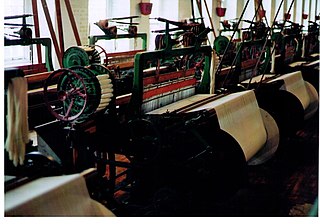
A power loom is a mechanized loom, and was one of the key developments in the industrialization of weaving during the early Industrial Revolution. The first power loom was designed and patented in 1785 by Edmund Cartwright. It was refined over the next 47 years until a design by the Howard and Bullough company made the operation completely automatic. This device was designed in 1834 by James Bullough and William Kenworthy, and was named the Lancashire loom.

EbenSumner Draper was an American businessman and politician from Massachusetts. He was for many years a leading figure in what later became the Draper Corporation, the dominant manufacturer of cotton textile process machinery in the world during the late 19th and early 20th centuries. He served as the 44th Governor of Massachusetts from 1909 to 1911.

In the manufacture of cloth, warp and weft are the two basic components in weaving to transform thread and yarn into textile fabrics. The vertical warp yarns are held stationary in tension on a loom (frame) while the horizontal weft is drawn through (inserted) over and under the warp thread. In the terminology of weaving, each warp thread is called a warp end; a pick is a single weft thread that crosses the warp thread, synonymous terms are fill yarn and filling yarn.

The flying shuttle is a type of weaving shuttle. It was a pivotal advancement in the mechanisation of weaving during the initial stages of the Industrial Revolution, and facilitated the weaving of considerably broader fabrics, enabling the production of wider textiles. Moreover, its mechanical implementation paved the way for the introduction of automatic machine looms.

Textile manufacture during the British Industrial Revolution was centred in south Lancashire and the towns on both sides of the Pennines in the United Kingdom. The main drivers of the Industrial Revolution were textile manufacturing, iron founding, steam power, oil drilling, the discovery of electricity and its many industrial applications, the telegraph and many others. Railroads, steamboats, the telegraph and other innovations massively increased worker productivity and raised standards of living by greatly reducing time spent during travel, transportation and communications.

Textile manufacturing is a major industry. It is largely based on the conversion of fibre into yarn, then yarn into fabric. These are then dyed or printed, fabricated into cloth which is then converted into useful goods such as clothing, household items, upholstery and various industrial products.
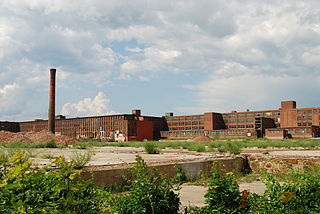
The Draper Corporation was once the largest maker of power looms for the textile industry in the United States. It operated in Hopedale, Massachusetts for more than 130 years.
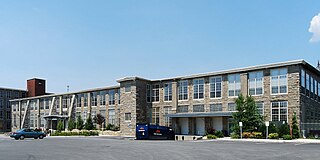
Clover Leaf Mills is a historic cotton textile mill complex located at 1 & 21 Father DeValles Boulevard in Fall River, Massachusetts. Begun in 1884, the mill is a good example of 1880s industrial architecture. The site was added to the National Register of Historic Places in 1983.

Sir Richard Arkwright's Masson Mill is a water-powered cotton spinning mill situated on the west bank of the River Derwent in Matlock Bath, Derbyshire in England. This mill was built in 1783. It forms part of the Derwent Valley Mills, a World Heritage Site. Nearby is Willersley Castle, the house Richard Arkwright built for himself within the parish of Matlock.
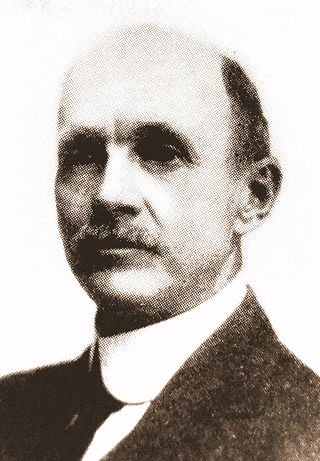
James Henry Northrop, was born in Keighley, West Yorkshire in the United Kingdom, where he worked in the textile industry. He emigrated to Boston, Massachusetts, in 1881. By 1898, working in Hopedale, Massachusetts for George Draper and Sons he had filed several hundred patents some of which were used in the Northrop Loom. He retired at 42. He died in Santa Ana, California on 12 December 1940, at 84.

The Lancashire Loom was a semi-automatic power loom invented by James Bullough and William Kenworthy in 1842. Although it is self-acting, it has to be stopped to recharge empty shuttles. It was the mainstay of the Lancashire cotton industry for a century.

The Roberts loom was a cast-iron power loom introduced by Richard Roberts in 1830. It was the first loom that was more viable than a hand loom and was easily adjustable and reliable, which led to its widespread use in the Lancashire cotton industry.

A rapier loom is a shuttleless weaving loom in which the filling yarn is carried through the shed of warp yarns to the other side of the loom by finger-like carriers called rapiers.
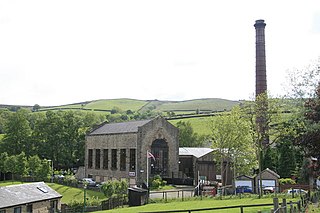
Bancroft Shed was a weaving shed in Barnoldswick, Lancashire, England, situated on the road to Skipton. Construction was started in 1914 and the shed was commissioned in 1920 for James Nutter & Sons Limited. The mill closed on 22 December 1978 and was demolished. The engine house, chimneys and boilers have been preserved and maintained as a working steam museum. The mill was the last steam-driven weaving shed to be constructed and the last to close.

The more looms system was a productivity strategy introduced in the Lancashire cotton industry, whereby each weaver would manage a greater number of looms. It was an alternative to investing in the more productive Northrop automatic looms in the 1930s. It caused resentment, resulted in industrial action, and failed to achieve any significant cost savings.

"Kissing the shuttle" is the term for a process by which weavers used their mouths to pull thread through the eye of a shuttle when the pirn was replaced. The same shuttles were used by many weavers, and the practice was unpopular. It was outlawed in the U.S. state of Massachusetts in 1911 but continued even after it had been outlawed in Lancashire, England in 1952. The Lancashire cotton industry was loath to invest in hand-threaded shuttles, or in the more productive Northrop automatic looms with self-threading shuttles, which were introduced in 1902.